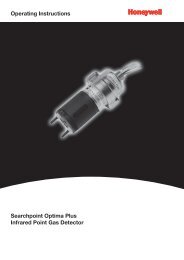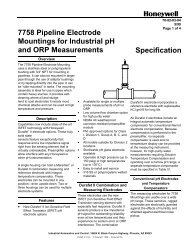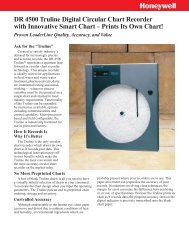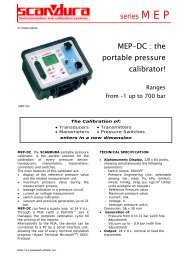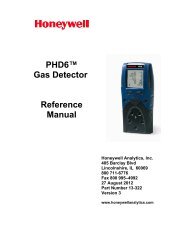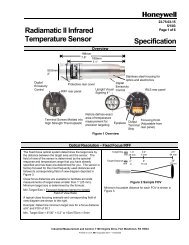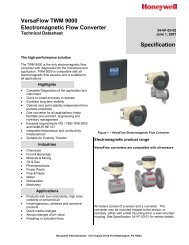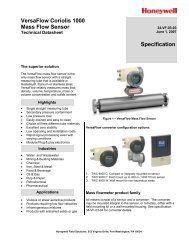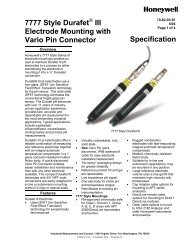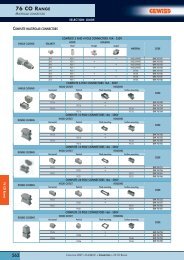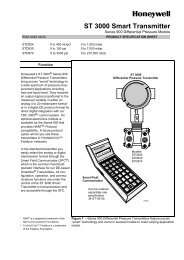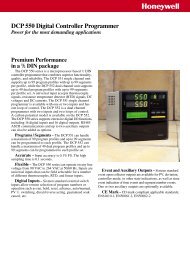GasAlert Quattro // Operator's Manual - Merkantile
GasAlert Quattro // Operator's Manual - Merkantile
GasAlert Quattro // Operator's Manual - Merkantile
Create successful ePaper yourself
Turn your PDF publications into a flip-book with our unique Google optimized e-Paper software.
Operator’s <strong>Manual</strong>1, 2, 3, and 4-Gas Detector
Table of ContentsLimited Warranty and Limitation LiabilityContacting BW Technologies by HoneywellIntroduction . . . . . . . . . . . . . . . . . . . . . . . . . . . . . . . . . . . . . . . 1Zeroing the Sensors . . . . . . . . . . . . . . . . . . . . . . . . . . . . . . . . 1Safety Information - Read First . . . . . . . . . . . . . . . . . . . . . . . 1Parts of the <strong>GasAlert</strong><strong>Quattro</strong> . . . . . . . . . . . . . . . . . . . . . . . . . 4Screen Elements . . . . . . . . . . . . . . . . . . . . . . . . . . . . . . . . . . 5Pushbutton . . . . . . . . . . . . . . . . . . . . . . . . . . . . . . . . . . . . . . . 6Sensor Poisons and Contaminants . . . . . . . . . . . . . . . . . . . . 7Connecting the Gas Cylinder to the Detector . . . . . . . . . . . . . 8Calibration . . . . . . . . . . . . . . . . . . . . . . . . . . . . . . . . . . . . . . . 9Bump Test . . . . . . . . . . . . . . . . . . . . . . . . . . . . . . . . . . . . . . 12Alarms . . . . . . . . . . . . . . . . . . . . . . . . . . . . . . . . . . . . . . . . . 13User Options and Sensor Configuration . . . . . . . . . . . . . . . . 16Maintenance . . . . . . . . . . . . . . . . . . . . . . . . . . . . . . . . . . . . . 19WEEE Directive and Battery Directive . . . . . . . . . . . . . . . . . 23Removal and Disposal of the Coin Cell . . . . . . . . . . . . . . . . 24Specifications . . . . . . . . . . . . . . . . . . . . . . . . . . . . . . . . . . . . 27ATEX Performance Approval . . . . . . . . . . . . . . . . . . . . . . . . 30Troubleshooting . . . . . . . . . . . . . . . . . . . . . . . . . . . . . . . . . . 33Replacement Parts and Accessories . . . . . . . . . . . . . . . . . . 41
Limited Warranty and Limitation LiabilityBW Technologies LP (BW) warrants the product to be free from defects in material and workmanship under normal use and service for a period oftwo years, beginning on the date of shipment to the buyer. This warranty extends only to the sale of new and unused products to the original buyer.BW’s warranty obligation is limited, at BW’s option, to refund of the purchase price, repair or replacement of a defective product that is returned toa BW authorized service center within the warranty period. In no event shall BW’s liability hereunder exceed the purchase price actually paid by thebuyer for the Product.This warranty does not include:a) fuses, disposable batteries or the routine replacement of parts due to the normal wear and tear of the product arising from use;b) any product which in BW’s opinion, has been misused, altered, neglected or damaged, by accident or abnormal conditions of operation,handling or use;c) any damage or defects attributable to repair of the product by any person other than an authorized dealer, or the installation of unapprovedparts on the product; orThe obligations set forth in this warranty are conditional on:a) proper storage, installation, calibration, use, maintenance and compliance with the product manual instructions and any other applicablerecommendations of BW;b) the buyer promptly notifying BW of any defect and, if required, promptly making the product available for correction. No goods shall bereturned to BW until receipt by the buyer of shipping instructions from BW; andc) the right of BW to require that the buyer provide proof of purchase such as the original invoice, bill of sale or packing slip to establish that theproduct is within the warranty period.THE BUYER AGREES THAT THIS WARRANTY IS THE BUYER’S SOLE AND EXCLUSIVE REMEDY AND IS IN LIEU OF ALL OTHER WARRANTIES, EXPRESS OR IMPLIED,INCLUDING BUT NOT LIMITED TO ANY IMPLIED WARRANTY OF MERCHANTABILITY OR FITNESS FOR A PARTICULAR PURPOSE. BW SHALL NOT BE LIABLE FOR ANYSPECIAL, INDIRECT, INCIDENTAL OR CONSEQUENTIAL DAMAGES OR LOSSES, INCLUDING LOSS OF DATA, WHETHER ARISING FROM BREACH OF WARRANTY ORBASED ON CONTRACT, TORT OR RELIANCE OR ANY OTHER THEORY.Since some countries or states do not allow limitation of the term of an implied warranty, or exclusion or limitation of incidental or consequentialdamages, the limitations and exclusions of this warranty may not apply to every buyer. If any provision of this warranty is held invalid orunenforceable by a court of competent jurisdiction, such holding will not affect the validity or enforceability of any other provision.Contacting BW Technologies by HoneywellUSA: 1-888-749-8878 Canada: 1-800-663-4164Europe: +44(0) 1295 700300 Other countries: +1-403-248-9226Email us at: info@gasmonitors.comVisit BW Technologies by Honeywell’s website at: www.gasmonitors.com
<strong>GasAlert</strong><strong>Quattro</strong>IntroductionThe operator’s manual provides basic information to operatethe <strong>GasAlert</strong><strong>Quattro</strong> gas detector. For complete operatinginstructions, refer to the <strong>GasAlert</strong><strong>Quattro</strong> Technical ReferenceGuide provided on the CD-ROM. The <strong>GasAlert</strong><strong>Quattro</strong> gasdetector (“the detector”) is designed to warn of hazardous gaslevels above user-defined alarm setpoints.The detector is a personal safety device. It is your responsibilityto respond properly to the alarm.NoteThe detector is shipped with English as the defaultdisplayed language. Additional languages providedare French, German, Portuguese, and Spanish. Thescreens for the additional languages are displayed onthe detector and in the corresponding operator’smanual.Zeroing the SensorsTo zero the sensors, refer to steps #1-3 in Calibration onpage 9.Safety Information - Read FirstUse the detector only as specified in this operator’s manual andthe technical reference guide, otherwise protection provided bythe detector may be impaired. Read the following Cautionsbefore using the detector.a Cautions• Warning: Substitution of components may impair IntrinsicSafety.• Before using the detector, refer to Sensor Poisons andContaminants.• Protect the combustible sensor from exposure to leadcompounds, silicones, and chlorinated hydrocarbons.Although certain organic vapors (such as leaded gasolineand halogenated hydrocarbons) may temporarily inhibitsensor performance, in most cases the sensor will recoverafter calibration.• Caution: For safety reasons, this equipment must beoperated and serviced by qualified personnel only. Readand understand the technical reference guide completelybefore operating or servicing.1
<strong>GasAlert</strong><strong>Quattro</strong>Operator’s <strong>Manual</strong>• If using the detector near its upper or lower operatingtemperature, BW Technologies by Honeywell recommendszeroing or activating the detector in that environment.• Charge the detector before first-time use. BW Technologiesby Honeywell recommends the detector be charged afterevery workday.• Calibrate the detector before first-time use and then on aregular schedule, depending on use and sensor exposureto poisons and contaminants. BW recommends that thesensors must be calibrated regularly and at least onceevery 180 days (6 months).• Calibrate only in a safe area that is free of hazardous gasin an atmosphere of 20.9% oxygen.• The combustible sensor is factory calibrated to 50% LELmethane. If monitoring a different combustible gas in the% LEL range, calibrate the sensor using the appropriategas.• Only the combustible gas detection portion of thisinstrument has been assessed for performance by CSAInternational.• BW recommends that the combustible sensor be checkedwith a known concentration of calibration gas after anyexposure to contaminants/poisons such as sulfurcompounds, silicon vapors, halogenated compounds, etc.• BW recommends to bump test the sensors before eachday’s use to confirm their ability to respond to gas byexposing the detector to a gas concentration that exceedsthe alarm setpoints. <strong>Manual</strong>ly verify that the audible, visual,and vibrator alarms are activated. Calibrate if the readingsare not within the specified limits.• For an additional bump test caution relating to the ATEXperformance certification, refer to Bump Test on page 12.• Caution: High off-scale LEL readings may indicate anexplosive concentration.• Any rapid upscaling reading followed by a declining orerratic reading may indicate a gas concentration beyondupper scale limit, which can be hazardous.• For use only in potentially explosive atmospheres whereoxygen concentrations do not exceed 20.9% (v/v). Oxygendeficient atmospheres (
<strong>GasAlert</strong><strong>Quattro</strong>Safety Information - Read First• Warning: The lithium battery (QT-BAT-R01) may presenta risk of fire or chemical burn hazard if misused. Do notdisassemble, heat above 212°F (100°C), or incinerate.• Warning: Do not use any other lithium batteries with the<strong>GasAlert</strong><strong>Quattro</strong> detector. Use of any other cell can causefire and/or explosion. To order and replace the QT-BAT-R01lithium battery, contact BW Technologies by Honeywell.• Warning: Lithium polymer cells exposed to heat at 266°F(130°C) for 10 minutes can cause fire and/or explosion.• ec Warning: This instrument contains a lithium polymerbattery. Dispose of used lithium cells immediately. Do notdisassemble and do not dispose of in fire. Do not mix withthe solid waste stream. Spent batteries must be disposedof by a qualified recycler or hazardous materials handler.• Keep lithium cells away from children.• Deactivating the detector by removing the battery pack maycause improper operation and harm the detector.3
<strong>GasAlert</strong><strong>Quattro</strong>Operator’s <strong>Manual</strong>Parts of the <strong>GasAlert</strong><strong>Quattro</strong>4Item Description Item Description Item Description Item Description1 IntelliFlash4 Pushbutton 7 Liquid crystal display 10 Alligator clip(green LED)(LCD)2 Visual alarm indicator(red LED)3 Hydrogen sulfide(H 2 S) sensor5 Combustible (LEL)sensor6 Carbon monoxide(CO) sensor8 Audible alarm 11 Battery pack9 Oxygen (O 2 ) sensor 12 Charging connectorand IR interface
Screen Elements<strong>GasAlert</strong><strong>Quattro</strong>Screen Elements5
<strong>GasAlert</strong><strong>Quattro</strong>Operator’s <strong>Manual</strong>PushbuttonPushbuttonCDescription• To activate the detector, press and hold C in a safe area that is free of hazardous gas and inan atmosphere of 20.9% oxygen.• To deactivate the detector, press and hold C during the powering off countdown. ReleaseC when OFF displays.• To view the date/time, current battery power, calibration due date, bump test due date,TWA, STEL, and peak readings, press C twice rapidly. To clear the TWA, STEL, andpeak readings, press and hold C when the LCD displays Hold C to reset peaks, TWA,STEL.• To initiate calibration, press and hold C while the detector performs the OFF countdown.Continue holding C while the LCD briefly deactivates and then reactivates to begin thecalibration countdown. Release C when Calibration started displays.• To activate the backlight, press C and release.• To acknowledge latching alarms, press C.• To acknowledge a low alarm and disable the audible alarm, press C. The Low AlarmAcknowledge option must be enabled in Fleet Manager II.• To acknowledge any of the “due today” messages (calibration and bump test) press C.If enabled, the force calibration and force bump features cannot be bypassed.6
Sensor Poisons and ContaminantsSeveral cleaners, solvents, and lubricants can contaminate andcause permanent damage to sensors. Before using cleaners,solvents, and lubricants in close proximity to the detector sensors,read the following caution and table.a CautionUse only the following BW Technologies by Honeywellrecommended products and procedures:• Use water based cleaners.• Use non-alcohol based cleaners.• Clean the exterior with a soft, damp cloth.• Do not use soaps, polishes, or solvents.<strong>GasAlert</strong><strong>Quattro</strong>Sensor Poisons and ContaminantsThe following table lists common products to avoid usingaround sensors.Cleaners andLubricantsBrake cleanersLubricantsRust inhibitorsWindow and glasscleanersDishsoapsCitrus basedcleanersAlcohol basedcleanersHand sanitizerAnionicdetergentsMethanol(fuels andantifreezes)SiliconesSilicone cleanersand protectantsSilicone basedadhesives, sealants,and gelsHand/body andmedicinal creams thatcontain siliconeTissues containingsiliconeMold releasing agentsPolishesAerosolsBugrepellentsand spraysLubricantsRustinhibitorsWindowcleaners7
<strong>GasAlert</strong><strong>Quattro</strong>Operator’s <strong>Manual</strong>Connecting the Gas Cylinder to the Detector8
CalibrationCalibration is performed to adjust the sensitivity levels ofsensors to ensure accurate responses to gas.This calibration procedure is written as the procedure is intended.If an error or alarm screen displays, refer to Calibration Troubleshootingin the <strong>GasAlert</strong><strong>Quattro</strong> Technical Reference Guide.a CautionCalibrate only in a safe area that is free of hazardousgas in an atmosphere of 20.9% oxygen.If performing single gas calibration, calibrate O 2 first.NoteThe maximum hose length for calibration is 3 ft. (1 m).The following steps are written for use with a standardquad gas cylinder.Calibration can only be aborted after the sensors havebeen zeroed. If C is pressed to abort, CALIBRATIONcancelled displays.1. Press and hold C as thedetector performs the Poweringoff countdown.Continue holding C when OFFdisplays and the detector brieflydeactivates.2. The detector activates againand performs the calibrationcountdown. Continue holding untilStarting Calibration displays.3. The detector enters the zerofunction. zeroing displays whilethe detector zeros all of thesensors.a CautionIf a sensor fails to zero, it cannot becalibrated. Refer to Startup Self-TestTroubleshooting in the<strong>GasAlert</strong><strong>Quattro</strong> Technical ReferenceGuide.<strong>GasAlert</strong><strong>Quattro</strong>Calibration9
<strong>GasAlert</strong><strong>Quattro</strong>Operator’s <strong>Manual</strong>If the IR Lock option is enabled, thefollowing screen displays to indicatecalibration can only be performedusing an IR device (MicroDock II orIR Link).4. When the following screendisplays, attach the calibration capand apply calibration gas at a flowrate of 250-500 ml/min. Refer toConnecting the Gas Cylinder tothe Detector.If a sensor is not yet due forcalibration, its box will have a greyedout checkmark.5. The detector initially tests forgas. When a sufficient amount ofgas is detected, displaysbeside each gas that is detected.6. The detector then beginscalibrating the sensors. Thefollowing activities occur duringthe span:• calibrating displays at the bottomof the screen.• Gas values adjust during thespan.• Target gas values that aredefined in Fleet Manager II displayabove or below the adjustinggas value.To abort calibration after the sensorshave been zeroed, press C.7. When the following screendisplays, close the valve on thegas cylinder and remove thecalibration cap from the detector.A check mark displays besideeach sensor that has calibratedsuccessfully.10
<strong>GasAlert</strong><strong>Quattro</strong>Calibration8. When calibration is complete,the following screen displays.NoteThe calibration due date cannotbe reset for a sensor that failscalibration. If a sensor fails or anerror screen displays, refer toCalibration Troubleshooting in the<strong>GasAlert</strong><strong>Quattro</strong> TechnicalReference Guide.9. All successfully calibratedsensors automatically reset to thenumber of days defined in the CalInterval field in Fleet Manager II.The calibration due dates can bechanged in Fleet Manager II.10. The detector now entersnormal operation.11
<strong>GasAlert</strong><strong>Quattro</strong>Operator’s <strong>Manual</strong>Bump TestA bump test applies test gas to force the detector into alarm. Abump test should be performed regularly to confirm the sensorsare responding correctly to gas, and that the audible, visual andvibrator alarms activate during an alarm condition.The detector can also prompt for a bump test during startupwhen the Bump Test Interval is defined. Refer to the <strong>GasAlert</strong>-<strong>Quattro</strong> Technical Reference Guide.a CautionBW recommends to bump test the sensors beforeeach day’s use to confirm their ability to respond togas by exposing the sensors to a gas concentrationthat exceeds alarm setpoints.To operate the detector in accordance with ATEXperformance certification requirements, the user mustcomplete a bump test before each day’s use.(Per EN 60079-29-1 and EN 60079-29-2.)1. Connect the calibration hose to the 0.5 l/min regulatoron the gas cylinder. Refer to Connecting the GasCylinder to the Detector.To bump test using the MicroDock II station, refer tothe MicroDock II User <strong>Manual</strong>.2. Connect the calibration hose to the intake inlet on thecalibration cap. Arrows on the calibration cap indicatethe direction of gas flow.3. Attach and tighten the calibration cap onto thedetector and apply gas. Verify the visual, audible, andvibrator alarms activate.4. Close the regulator and remove the calibration cap.The detector temporarily remains in alarm until thegas clears from the sensors.NoteIn normal operating mode, it is possible to displaymeasured values with calibration gas applied todetermine any measurement errors.12
Alarms<strong>GasAlert</strong><strong>Quattro</strong>AlarmsRefer to the following table for information about alarms and corresponding screens. For more information about alarms refer to the<strong>GasAlert</strong><strong>Quattro</strong> Technical Reference Guide.Alarm Screen Alarm ScreenLow Alarm• Slow siren (upward tone)• Slow flash• Black box around gas flashes• Vibrator alarm activatesTWA Alarm• Fast siren (downward tone)• Fast flash• Black box around gas flashes• Vibrator alarm activatesHigh Alarm• Fast siren (downward tone)• Fast flash• Black box around gas flashes• Vibrator alarm activatesSTEL Alarm• Fast siren (downward tone)• Fast flash• Black box around gas flashes• Vibrator alarm activates13
<strong>GasAlert</strong><strong>Quattro</strong>Operator’s <strong>Manual</strong>Alarm Screen Alarm ScreenMulti Alarm• Alternating low and high alarmsiren and flash• Black box around gas flashes• Type of alarm alternates• Vibrator alarm activatesSensor Failure Alarm• displaysOver Limit (OL) Alarm• Fast siren (downward tone)• Fast flash• Black box around gas flashes• Vibrator alarm activatesNote: LCD may also displayan under limit reading (-OL)Normal Deactivation• Sequence of alternating beepsand alternating flashes• Vibrator alarm activates• Countdown initiates• OFF displaysNoteIf enabled, during an alarm condition the Latching Alarms option causes the low and high gas alarms (audible, visual, and vibrator) topersist until the alarm is acknowledged by pressing C and the gas concentration is below the low alarm setpoint. The peak concentrationvalues display continually until the alarm no longer exists. Enable/disable Latching Alarms in Fleet Manager II. Local regulations mayrequire the Latching Alarms option be enabled. The Latching Alarms option must be enabled if the detector is to be used in accordancewith ATEX gas performance certification requirements (BAM).14
<strong>GasAlert</strong><strong>Quattro</strong>AlarmsAlarm Screen Alarm ScreenLow Battery Alarm• Sequence of 10 rapid sirensand alternating flashes with7 seconds of silence in between(continues for 15 minutes)• flashes• Vibrator alarm pulses• After 15 minutes of the low batteryalarm sequence, the detectorenters critical battery alarm (seeCritical Battery Alarm below)Critical Battery Alarm• Fifteen minutes after low batteryalarm activates, sequence of 10rapid sirens and alternatingflashes with 1 second of silence inbetween (sequence reactivatesseven times)• Vibrator alarm pulses• Low Battery Powering Off displaysand the detector deactivatesConfidence/compliance Beep• One beep every 1-120 seconds(beep frequency is defined withConfidence/compliance BeepInterval option)IntelliFlash(default: one flash every 1 second)• One flash every 1-120 seconds(flash frequency is defined withIntelliFlash Interval option)Heartbeat• pulses once every second toverify detector is operating correctlyNote: Confidence/compliance beep andIntelliFlash automaticallydeactivateduring a low batteryalarm, calibration fail,bump test fail, self-testfail, and in an alarmcondition.NoteIf the Low Alarm Acknowledge option is enabled, theaudible alarm can be disabled during a low alarm condition.The LED and visual alarm indicators remain active until thealarm condition changes or the detector deactivates. PressC to acknowledge the low alarm and deactivate the audiblealarm. If the alarm escalates to a high, TWA, or STEL alarm,the audible alarm reactivates.15
<strong>GasAlert</strong><strong>Quattro</strong>Operator’s <strong>Manual</strong>User Options and Sensor ConfigurationIn order to modify user options and detector configuration, thefollowing items are required:• Detector• IR Link adapter or MicroDock II• Fleet Manager II softwareThe following section describes some of the configurationoptions available in the detector. Refer to the <strong>GasAlert</strong><strong>Quattro</strong>Technical Reference Guide and Fleet Manager II Operator’s<strong>Manual</strong> for complete information.Device ConfigurationThe Device Configuration section displays data about thedetector, allows for a startup message to be entered, anddefines and enables/disables settings for the detector.• Serial Number Field: This field displays the serial number(e.g. QA111-001000) of the detector.• Firmware Version: This field displays the current firmwareversion that displays on the detector LCD during thestartup sequence. If new firmware is uploaded to thedetector, the Firmware Version field automatically updates.• Hardware Version: This field displays the current hardwareversion of the detector.• Startup Message: Enter text to display on the detectorLCD during startup (50 characters maximum). Enter informationsuch as employee name, plant, area, emergencynumber(s), etc.16• Lockout on Self-Test Error: If Lockout on Self-Test Erroris enabled and a failure occurs during the self-test, thescreen displays Sensor Self Test Error LockoutEnabled... and the detector deactivates.• Safe Mode: If enabled, SAFE displays continuously on theLCD unless an alarm condition occurs.• Confidence/Compliance Beep: If enabled, the Confidence/ComplianceBeep provides continuous audible confirmationthat the detector is operating correctly.Frequency of the beep is defined with the Confidence/Compliance Beep Interval option (every 1-120 seconds).NoteConfidence/Compliance Beep automatically disablesduring a low battery alarm, self-test fail, calibrationfail, bump test fail, and when an alarm event occurs.• Latching Alarms: If enabled, during an alarm conditionthe Latching Alarms option causes the low and high gasalarms (audible, visual, and vibrator) to persist until thealarm is acknowledged and the gas concentration is belowthe low alarm setpoint. The LCD displays the peak concentrationuntil the alarm no longer exists. Local regulationsin your region may require the Latching Alarmsoption be enabled.• Force Calibration: If enabled, during startup if a sensor(s)is past due for calibration, the sensor(s) must be calibratedto continue and enter normal operation.A value must be entered in the Cal Interval (days) fieldbefore enabling Force Calibration.
• Force Bump: If enabled, during startup if the sensor(s) ispast due for a bump test, a bump test should be performedand the overdue sensor(s) must enter into alarm.A value must be entered in the Bump Interval (days) fieldbefore enabling Force Bump.• Cal IR Lock: If enabled, the sensor(s) can only be calibratedusing an IR device (IR Link or the MicroDock II station).NoteIf the Cal IR Lock option is enabled and a manualcalibration is attempted, the sensor(s) will auto zerobut they will not be calibrated.• Flip Display: The detector can display screens at 0°(upright) or 180° (upside down), depending upon how thedetector is worn by the worker. If the Flip Display option isenabled, the LCD is viewed at 180° (upside down).• Stealth: When enabled, the following features are disabled:backlight, audible alarms, visual alarms, IntelliFlash,and confidence/compliance beep. Only the vibratorand the LCD readings activate during an alarm condition.NoteShould the user wish to comply with ATEXperformance certifications, stealth mode must bedisabled.• Datalog Interval: The Datalog Interval (seconds) fielddefines how often the detector records a datalog (every 1-120 seconds). Enter the desired value.<strong>GasAlert</strong><strong>Quattro</strong>User Options and Sensor ConfigurationThe total number of 8-hour days datalogs that can berecorded is assuming 90% of the day has no gas concentrations.When the memory is full, the detector replaces the oldestdatalogs with the most recent datalogs.• IntelliFlash Interval: The IntelliFlash Interval (seconds)field defines how often (every 1-120 seconds) the IntelliFlashoccurs.• Confidence/Compliance Beep Interval: Define howoften (every 1-120 seconds) the confidence/compliancebeep occurs.• Language: The Language field provides a drop downmenu that includes the following language options: English,Français (French), Deutsch (German), Español(Spanish), Português (Portuguese). Select the languagefrom the drop-down menu in Fleet Manager II.Sensor Configuration• Sensor Disabled: Enables/disables the selected sensor.a WarningUse extreme caution when disabling a sensor. Thedisabled sensor cannot detect and alarm against theapplicable gas.• Calibration Gas (ppm): Define the span gas concentrationfor each sensor. The span gas concentration mustmatch the span value on the gas cylinder.• Calibration Interval: Define how often a sensor should becalibrated (0-365 days) in the Calibration Interval (days)17
<strong>GasAlert</strong><strong>Quattro</strong>Operator’s <strong>Manual</strong>field. A different calibration interval can be defined for eachsensor.a CautionBW recommends that the sensors be calibrated atleast once every 180 days (6 months).• Bump Interval: Define how often a bump test should beperformed for each sensor (0-365 days) in the BumpInterval (days) field. A different bump interval can bedefined for each sensor.• Low Alarm: Define the low alarm setpoints for each sensor.Refer to Sample Gas Alarm Setpoints for factorydefined alarm setpoints in the <strong>GasAlert</strong><strong>Quattro</strong> TechnicalReference Guide.• High Alarm: Define the high alarm setpoints for each sensor.Refer to Sample Gas Alarm Setpoints for factorydefined alarm setpoints in the <strong>GasAlert</strong><strong>Quattro</strong> TechnicalReference Guide.• TWA Alarm: The time-weighted average (TWA) is a safetymeasure used to calculate accumulated averages ofgases. Using the US Occupational Safety and HealthAdministration (OSHA) method or the American Conferenceof Governmental Hygienists (ACGIH) method, anaverage is calculated to ensure the detector alarms whenthe TWA has accumulated.• STEL Alarm: The short-term exposure limit (STEL) is themaximum permissible gas concentration a worker can besafely exposed to for short periods of time (5-15 minutesmaximum).18• Correction Factor (LEL): The Correction Factor optiondefines compensation factors for hydrocarbons other thanmethane. The correction factor is only applicable to LELand can only be applied if the LEL sensor has been calibratedwith methane. Detector operation using LEL correctionfactors has not been tested by BAM.• STEL Interval: Define the short-term exposure limit(STEL) from 5-15 minutes (toxic sensors only).• TWA Period (hours): Define the time-weighted average(TWA) from 4-16 minutes (toxic sensors only).• TWA Method: Select either the US Occupational Safetyand Health Administration (OSHA) or the American Conferenceof Governmental Industrial Hygienists (ACGIH)TWA calculating method.• 50% LEL = (%CH4): Enter a percentage value to displaythe LEL reading as %vol., assuming a methane environment(LEL only).• Auto Zero on Startup: When enabled, the sensors automaticallyzero during the startup sequence. The Auto Zeroon Startup option is available for the CO, H 2 S, LEL, and O 2sensors (each sensor is enabled individually).• LEL by Volume CH4: If enabled, the detector displays theLEL value as %vol. assuming a methane environment.NoteIf changing the measurement unit from % LEL to %Vol. or from % Vol. to % LEL, a calibration must becompleted and the alarm setpoints changed. Forcalibration information refer to Calibration on page 9and for alarm setpoint information refer to Gas Alarm
<strong>GasAlert</strong><strong>Quattro</strong>MaintenanceSetpoints in the <strong>GasAlert</strong><strong>Quattro</strong> Technical ReferenceGuide.• 10% LEL (of reading) Over-span: If enabled, the detectorautomatically over-spans the LEL sensor by 10% of thespan concentration. Enable 10% LEL (of reading) Over-Span to ensure the detector is in compliance with CAN/CSA C22.2 No. 152.• 20.8 Base Reading: If enabled, the detector is configuredto detect 20.8% O2 as ambient air. When disabled, thedetector is configured to detect 20.9% O 2 as ambient air.• Low Alarm Acknowledge: If enabled, the audible alarmcan be temporarily disabled during a low alarm by pressingC. The vibrator, alarm LEDs, and LCD remain operational(toxic and LEL only).MaintenanceTo maintain the detector in good operating condition, performthe following basic maintenance as required.• Calibrate, bump test, and inspect the detector on aregular schedule.• Maintain an operations log of all maintenance, bump tests,calibrations, and alarm events.• Clean the exterior with a soft damp cloth. Do not usesolvents, soaps, or polishes. Refer to Sensor Poisonsand Contaminants.Rechargeable Battery CapacityA rechargeable battery’s runtime decreases approximately 20%over a two-year period of typical use.Battery Pack Retaining ScrewThe retaining screw (QAQD-20x) provided with the detectormust be used to lock the battery pack on all European andIECEx scheme detectors, and on all Canadian and U.S. ZoneCertified detectors.The screwdriver included with the detector has a double-endeddriver. Loosen the brass nut to switch between a Phillips headand a hex head.A hex tool is required to tighten and loosen the retaining screw.Tighten the screw 1-2 turns using 3-4 in-lbs of torque. Do notovertighten the screw.19
<strong>GasAlert</strong><strong>Quattro</strong>Operator’s <strong>Manual</strong>Replacing the Battery PackThe alkaline and rechargeable battery packs can be changed inhazardous locations.1. Press and hold C to deactivate the detector.2. If using the retaining screw, loosen it 1-2 turns. Pushthe battery release latch toward the top of the detectorto release the battery pack.3. From the top of the battery pack, lift upward toremove.204. Before replacing the battery pack, ensure the seal onthe instrument and battery pack is free of debris andmoisture.5. Insert a new battery pack. Insert the bottom of thebattery pack first, then lower the top into place. Pressuntil the release tab engages. Tighten the retainingscrew if required.Charging the Rechargeable Battery Packa WarningTo avoid personal injury and/or damage to thedetector, adhere to following:Charge only in a safe area that is free of hazardousgas within temperatures of 32°F to 104°F (0°C to 40°C).Charge the battery immediately when the detectoremits a low battery alarm.Charge the lithium battery pack using the BW suppliedcharger and charger adapter only. The chargingadapter is specific to your region. Use of the chargingadapter outside your region will damage the chargerand the detector. Failure to adhere to this caution canlead to fire and/or explosion.Charge the lithium battery after each workday.Ensure the charging connector surface is free ofdebris and moisture.1. Press and hold C to deactivate the detector, thenplug the charger into an AC outlet.
NoteThe time required to charge will increase if the detector isactivated.2. Connect the charging adapter to the detector IRreceptacle. Refer to the following illustration.<strong>GasAlert</strong><strong>Quattro</strong>MaintenanceReplacing the Alkaline Batteriesa WarningTo avoid personal injury and/or damage to the detector,use only BW recommended alkaline batteries. Refer toSpecifications.Change the alkaline batteries only in safe area that isfree of hazardous gas.1. Press and hold C to deactivate the detector.2. If using the retaining screw, loosen the retainingscrew 1-2 turns. Remove the alkaline battery pack.Refer to Replacing the Battery Pack.3. Unhook the ejector bar from the release clasp. Movethe ejector bar towards the top of the battery packuntil it is aligned horizontally over the batteries.3. The lithium battery may require 6 hours to reach fullcapacity.21
<strong>GasAlert</strong><strong>Quattro</strong>Operator’s <strong>Manual</strong>4. Using the tab, pull on the ejector bar.6. Remove the spent batteries. Reset the ejector bar toits original flat position. Ensure the ejector barengages the release clasp.5. To the left of the tab, pull up on the ejector bar.22
7. Insert the new batteries. Position the positive end ofthe battery at a 30° angle and insert into the batterypack before pushing the negative end down. Ensurethe batteries are not inserted over the tab.8. Before replacing the battery pack, ensure the seal onthe instrument and battery pack is free of debris andmoisture.9. Replace the battery pack by inserting the bottom first,then lower top into place. Ensure the tab is tucked inbefore replacing the battery pack.Press until the release tab engages. If required,tighten the retaining screw using 3-4 in. lbs torque.<strong>GasAlert</strong><strong>Quattro</strong>WEEE Directive and Battery DirectiveWEEE Directive and Battery DirectiveFailure to comply with the following battery removal and disposalinstructions may result in battery shorting, battery leakage,and/or other damage. Ensure a qualified techniciancompletes the following procedures.Removal and Disposal of the Alkaline Battery PackOnly a qualified technician should complete the following procedures.To remove the alkaline batteries, refer to steps #1 to #6 inReplacing the Alkaline Batteries on pages 21 and 22.Removal and Disposal of the Rechargeable Battery PackTo remove the rechargeable battery pack, refer to steps #1 to#3 in Replacing the Battery Pack on page 20.Dispose of the battery pack according local laws.23
<strong>GasAlert</strong><strong>Quattro</strong>Operator’s <strong>Manual</strong>Removal and Disposal of the Coin CellThe detector contains a coin cell to power the real-time clock.Only a qualified technician should complete the following procedure.1. Press and hold C to deactivate the detector.2. If the battery pack has not yet been removed, refer toRemoval and Disposal of the Alkaline BatteryPack on page 23 or Removal and Disposal of theRechargeable Battery Pack on page 23.3. Remove the six machine screws on the rear shell.4. Remove the two screws on the main PCB.5. Remove the main board.6. The coin cell is connected to the board by four leads.ItemDescription1 Rear machine screws (6)2 Rear shell3 Front shell and PCB4 Coin cell7. Clip the four leads individually to remove the coin cell.a CautionDo not touch two or more leads when disconnectingthe battery cell.8. Dispose of the coin cell according to local laws.24
Replacing the Sensors<strong>GasAlert</strong><strong>Quattro</strong>Removal and Disposal of the Coin Cell25
<strong>GasAlert</strong><strong>Quattro</strong>Operator’s <strong>Manual</strong>a WarningTo avoid personal injury and/or property damage, only usesensors that are specifically designed for the detector.Replace the sensors in a non-hazardous area.NoteDetectors that are configured for 1, 2, or 3 gases may containa dummy sensor in one of the four sensor locations.To replace a sensor or sensor filter, refer to the illustrationReplacing the Sensors and the following steps #1-8.1. Press and hold C to deactivate the detector. Pressthe release latch, and remove the battery pack.2. Remove the six machine screws from the rear shell.3. Remove the front shell.4. Remove the spent sensor(s). Ensure no damageoccurs to the LCD.5. Insert the new sensor(s).6. Before reassembling the detector, ensure the sealingsurfaces on the front and rear shells is free of debrisand moisture.7. Reassemble the detector. Press the front and rearshells together firmly to ensure a proper seal. Ensurethe front and rear shells have a tight, uniform 1/16 in.(1.5 mm) seal on all sides of the detector.8. Replace the six machine screws using 3-4 in. lbstorque. Do not overtighten the screws. Replace thebattery pack.9. New sensors must be calibrated prior to use.Calibrate the new sensor(s) immediately. Refer toCalibration.Replacing the Sensor FilterTo replace the filter, refer to the illustration Replacing the Sensorson page 25 and the following steps #1-6.1. Press and hold C to deactivate the detector. Pressthe release latch, and remove the battery pack.2. Remove the six machine screws from the rear shell.3. Remove the front shell. Remove the sensor filter.4. Refer to the following illustration before inserting thenew filter. Ensure the filter is laying flat and that theholes are correctly aligned over the filter posts.26
5. Before reassembling the detector, ensure the sealingsurfaces on the front and rear shells is free of debrisand moisture.6. Replace the front shell. Press the front and rearshells together firmly to ensure a proper seal. Ensurethe front and rear shells have a tight, uniform 1/16 in.(1.6 mm) seal on all sides of the detector.7. Replace the six machine screws using 3-4 in. lbstorque. Do not overtighten the screws. Replace thebattery pack.<strong>GasAlert</strong><strong>Quattro</strong>SpecificationsSpecificationsInstrument dimensions: 13 x 8.1 x 4.7 cm(5.1 x 3.2 x 1.5 in.)Weight:316 g (11.15 oz.) with rechargeable battery pack338 g (11.92 oz.) with alkaline battery packOperating temperature: -20°C to +50°C (-4°F to +122°F)Storage temperature: -40°C to +60°C (-40°F to +140°F)Operating humidity: 10% to 100% relative humidity(non-condensing)Operating environment specifications for use according toATEX performance approvals(Oxygen and methane measurements)Operating temperature range certified by BAM: -20°C to+50°COperating humidity as tested by BAM: 5% r.H. to 95% r.H.(Extended Range of Use for Temperature and Humidity asCompared To EN 50104 (Oxygen performance) and EN 67009-29-1 (LEL performance))Storage temperature range tested by BAM: -25°C to +60°COperating pressure as tested by BAM: 80 kPA to 120 kPaStorage duration: Two years from purchase date27
<strong>GasAlert</strong><strong>Quattro</strong>Operator’s <strong>Manual</strong>Dust and moisture ingress: IP66/67 (with screw engaged)Alarm setpoints: May vary by region and are user-definedDetection range:H 2 S: 0 - 200 ppm (0.1 ppm increments from 0.0 to 39.9 ppm / 1ppm increments above 40 ppm)CO: 0 - 1000 ppm (1 ppm increments)O 2 : 0 - 30.0% vol. (0.1% vol. increments)Combustible (LEL): 0 - 100% (1% LEL increments) or0 - 5.0% v/v methaneSensor type:H 2 S, CO, O 2 : Single plug-in electrochemical cellCombustibles: Plug-in catalytic beadO 2 measuring principle: Capillary controlled concentrationsensorBump test specified limits: BW recommends using a gas cylinderthat will ensure the combustible sensor has an accuracyof -0 to +20% of actual reading (reference CAN/CSA C22.2 No.152)Alarm conditions: TWA alarm, STEL alarm, low alarm, highalarm, multi alarm, over limit (OL) alarm, low battery alarm, criticallow battery alarm, sensor failure alarm, IntelliFlash,confidence/compliance beepAudible alarm: 95 dB at 30 cm (12 in.) variable pulsed beeperVisual alarm: Red light-emitting diodes (LEDs)IntelliFlash: Green light-emitting diode. Flash frequency isuser-defined with IntelliFlash interval optionConfidence/compliance beep: Audible beep from variablepulsed beeper. Beep frequency is user-defined with confidence/compliance beep interval option28Display: Alphanumeric liquid crystal display (LCD) with flipdisplay (0° or 180°) capability (user-defined in Fleet Manager II)Backlight: Activates upon startup and deactivates when selftestis complete. Activates when the pushbutton is pressed anddeactivates after 10 seconds. Also activates during an alarmcondition and remains lit until alarm ceasesInternal vibrator: Vibrates during activation, deactivation, andall alarmsSelf-test: Initiated during activation, self-test runs continuouslyon the battery and electrochemical sensors (H 2 S and CO) whiledetector is operationalCalibration: Zero and automatic spanUser options: Startup message, lockout on self-test error, safemode, IntelliFlash, confidence/compliance beep, latchingalarms, force calibration, force bump, calibration IR lock, flipdisplay, stealth mode, datalog interval, IntelliFlash interval, confidence/compliancebeep interval, and language selectionSensor options: Sensor enable/disable, calibration gasvalues, calibration interval, bump test interval, alarm setpoints(low/high/TWA/STEL), STEL interval, TWA period, auto zero atstartup enable/disable, LEL correction factor, 10% (of reading)over-span, low alarm acknowledge, O 2 measurement, LEL gasmeasurement, %vol methane measurementYear of manufacture: The detector's year of manufacture isdetermined from the serial number. The second and third numberafter the second letter determines the year of manufacture.E.g., QA111-001000 = 2011 year of manufactureApproved lithium battery for <strong>GasAlert</strong><strong>Quattro</strong> product:Lithium-ion polymer (QT-BAT-R01) as per standards UL913,EN60079-11, EN60079-0, IEC 60079-0, IEC 60079-11, EN60079-29-1, EN 50104, and C22.2 No. 157
Rechargeable battery (QT-BAT-R01) Temperature codeLithium polymer -20°C ≤ Ta ≤ +50°C T4Lithium battery operating time: One rechargeable lithiumpolymer battery provides the following operating runtimes:20 hours at 20°C (68°F)18 hours at -20°C (-4°F)Lithium Battery operating time (ATEX performanceapproval): 26 hours(tested according to EN 60079-29-1 (2007) and EN 50104(2010)).Approved alkaline battery pack for <strong>GasAlert</strong><strong>Quattro</strong>(QT-BAT-A01): as per standards UL913, EN60079-11,EN60079-0, EC 60079-0, IEC 60079-11, C22.2 No. 157Approved alkaline batteries for <strong>GasAlert</strong><strong>Quattro</strong> product:Duracell MN1500 -20°C ≤ Ta ≤ +50°C T4 (129.9°C)Energizer E91VP -20°C ≤ Ta ≤ +50°C T3C (135.3°C)AA alkaline battery operating time:14 hours at 20°C (68°F)Battery charger: Charging adapterFirst-time charge: 6 hoursNormal charge: 6 hoursWarranty: 2 years including sensorsEC Declaration of Conformity:http://www.gasmonitors.com/Declarations_of_Conformity<strong>GasAlert</strong><strong>Quattro</strong>SpecificationsApprovals:Approved by CSA to both U.S. and Canadian StandardsCAN/CSA C22.2 No. 157 and C22.2 152ANS/UL - 913 and ANSI/ISA - S12.13 Part 1CSAATEXClass I, Division 1, Group A, B, C, DCE 0539 g II 1 G Ex ia IIC Ga T4 for Zone0 Group IICKEMA 09 ATEX 0137EN 60079-0, EN 60079-11, EN 60079-26IECEx Ex ia IIC T4Ga IECEx CSA 09.0006IEC 60079-0, IEC 60079-11, IEC 60079-26BAM BAM 11 ATEX 1102 X EN 60079-29-1(for 0 up to 100% LEL methane)BAM/ZBF/006/11 EN 50104(for 0 up to 25% v/v oxygen)Firmware Release version GAQF_03_000This equipment has been tested and found to comply with the limits for a Class Bdigital device, pursuant to Part 15 of the FCC Rules and ICES-003 Canadian EMIrequirements. These limits are designed to provide reasonable protection againstharmful interference in a residential installation. This equipment generates, usesand can radiate radio frequency energy and, if not installed and used in accordancewith the instructions, may cause harmful interference to radio communications.However, there is no guarantee that interference will not occur in a particularinstallation. If this equipment does cause harmful interference to radio or televisionreception, which can be determined by turning the equipment off and on, the useris encouraged to try to correct the interference by one or more of the followingmeasures:• Reorient or relocate the receiving antenna.• Increase the separation between the equipment and receiver.• Connect the equipment into an outlet on a circuit different from that to whichthe receiver is connected.• Consult the dealer or an experienced radio/TV technician for help.29
<strong>GasAlert</strong><strong>Quattro</strong>Operator’s <strong>Manual</strong>ATEX Performance ApprovalSpecial conditions for safe useTo comply with ATEX performance approval requirements, thedetector must be operated in the following manner:Operating manual: Read and understand the operating manual.It is essential that the instructions for correct use are followed.Instrument power-up: The instrument must be powered up ina safe area that is free of hazardous gas and in an atmosphereof 20.9% oxygen. The detector must be turned on and verifiedto be operating in the normal measurement mode before it canbe brought into a hazardous area.Low-battery alarm: In the event of a low-battery alarm, theuser must leave the hazardous area immediately.Operating environment: The operating environment rangesthat apply for use of the <strong>GasAlert</strong><strong>Quattro</strong> according to ATEXperformance approvals for LEL and oxygen measurements areshown in Specifications on page 27. These specify the climaticrange within which the instrument can be used in conformity tothe performance certifications.General use: For use only in potentially explosive atmosphereswhere oxygen concentrations do not exceed 20.9% (v/v). Oxygendeficient atmospheres (
<strong>GasAlert</strong><strong>Quattro</strong>ATEX Performance ApprovalInstrument configuration: FleetManager II version 2.6.0 (orhigher) must be used to make configuration changes to the<strong>GasAlert</strong><strong>Quattro</strong>To operate the instrument in accordance with ATEX gas performanceconfiguration requirements:• Latching alarms must be enabled. See page 16.• Stealth mode must be disabled. See page 17.• Force Bump must be enabled. See page 12.• Bump Interval (days) must be set to 1 for all sensors.• IntelliFlash must be enabled. See page 17.• LEL Low Alarm and High Alarm values cannot be 0.Special conditions for safe use - oxygen measurementPerformance approval: The EC type examination certificateapplies to the measurement of oxygen up to 25% (v/v).Baseline and span zone blanking: Please note that oxygenmeasurements in the range from 20.5% (v/v) up to 21.3% (v/v)are indicated as “20.9%” oxygen on the instrument display.Measurement values in the range within ±0.2% (v/v) of the spangas concentration are displayed as the span gas concentration.For example, if the span gas concentration (used for oxygenbump testing) is configured as 18% (v/v), measured values inthe range of 17.8% (v/v) to 18.2% (v/v) will be indicated as“18.0%” oxygen on the instrument display.Oxygen measurement performance as tested by BAMOxygen response time t 90 : 15 seconds for oxygen deficiencyOxygen response time t 90 : 15 seconds for oxygen enrichmentMeasurement stabilization time: ≥ 120 secondsInstrument warmup time: 32 seconds31
<strong>GasAlert</strong><strong>Quattro</strong>Operator’s <strong>Manual</strong>Special conditions for safe use - LEL measurementPerformance approval: The EC type examination certificatefor LEL measurement applies only to the measurement ofmethane from 0% to 100% of the Lower Explosion Limit. TheLEL of methane is equal to 4.4% (v/v) methane in air. Additionaltests of a notified body would be required in addition to this certificatefor ATEX performance approval of the <strong>GasAlert</strong><strong>Quattro</strong>with respect to other combustible gases.Effect of other toxic gases on the LEL sensor: If substances(e.g. sensor poisons) that could interfere with and affect thesensitivity of the sensing device are to be expected in the atmosphereto be monitored which may cause a rapid change ofsensitivity, the calibration interval shall be reduced.Measuring gases of other installed measuring channels of the<strong>GasAlert</strong><strong>Quattro</strong> (e.g. hydrogen sulphide) may decrease thesensitivity of the LEL sensor. The calibration interval should bereviewed taking into account any degradation in performance.Changing measurement range from % LEL to % Vol.: Ifchanging the measurement unit from % LEL to % Vol. or from %Vol. to % LEL, a calibration must be completed and the alarmsetpoints changed. For calibration information refer to Calibrationon page 9 and for alarm setpoint information refer to GasAlarm Setpoints in the <strong>GasAlert</strong><strong>Quattro</strong> Technical ReferenceGuide.Measuring values from -6% LEL to +3% LEL are indicated as“0% LEL” in the measuring mode. Measuring values in the ±3%LEL ranges of the configured span gas concentration are indicatedas the configured span gas concentration.Methane LEL measurement performance as tested by BAMMethane response time t 90 : 15 secondsStabilization time for methane sensor: ≥ 120 secondsWarmup time: 32 secondsLEL correction factors: Detector operation using LEL correctionfactors has not been tested by BAM32
TroubleshootingIf the problem persists, contact BW Technologies by Honeywell.<strong>GasAlert</strong><strong>Quattro</strong>TroubleshootingProblem Possible Cause SolutionStartupThe detector does notactivate.Detector automaticallydeactivates.Depleted batteriesDamaged detectorAutomatic deactivation due tocritical low battery.Lockout on Self-Test Error isenabled and a sensor(s) hasfailed the startup self-test.Replace alkaline batteries. Refer to Replacing the AlkalineBatteries on page 21.Refer to Charging the Rechargeable Battery Pack onpage 20.Contact BW Technologies by Honeywell.Replace alkaline batteries. Refer to Replacing the AlkalineBatteries on page 21.Refer to Charging the Rechargeable Battery Pack on page 20.Refer to Replacing the Sensorson page 25 and Lockout onSelf-Test Error in the <strong>GasAlert</strong><strong>Quattro</strong> Technical ReferenceGuide.Sensor(s) requires calibration. Refer to Calibration on page 9.33
<strong>GasAlert</strong><strong>Quattro</strong>Operator’s <strong>Manual</strong>Problem Possible Cause SolutionThe detector enters alarmimmediately when activated.The activation startup self-testfails.Detector OperationSensor needs to stabilize.Low battery or critical lowbattery alarm.Hazardous environment.A new sensor has beeninsertedGeneral fault.Sensor error.Used sensor: Wait 60 secondsNew sensor: Wait 5 minutesReplace alkaline batteries. Refer to Replacing the AlkalineBatteries on page 21.Refer to Charging the Rechargeable Battery Pack onpage 20.Leave the area immediately. Deactivate and reactivate thedetector in a safe area that is free of hazardous gas, in anatmosphere of 20.9% oxygen.Calibrate the sensor.Contact BW Technologies by Honeywell.Refer to Startup Troubleshooting. If required, refer toReplacing the Sensors on page 25.Detector does not displaynormal gas reading afterstartup sequence.Sensors not stabilized.Used sensor: Wait 60 secondsNew sensor: Wait 5 minutesSensor(s) requires calibration. Refer to Calibration on page 9.Target gas is present.Detector is operating properly. Use caution in suspect areas.34
<strong>GasAlert</strong><strong>Quattro</strong>TroubleshootingProblem Possible Cause SolutionDetector does not respond topushbutton.Battery is in critical low batterystate or is completely depleted.Detector is performingoperations that do not requireuser input.Replace alkaline batteries. Refer to Replacing the AlkalineBatteries on page 21.Refer to Charging the Rechargeable Battery Pack onpage 20.Pushbutton operation restores automatically when theoperation ends.Sensor(s) requires calibration. Refer to Calibration on page 9.Detector does not accuratelymeasure gas.Detector is colder/hotter thangas temperature.Allow the detector to attain ambient temperature before use.Sensor filter is blocked. Refer to Replacing the Sensor Filter on page 26.Detector does not enter alarm.Alarm setpoint(s) are setincorrectly.Alarm setpoint(s) set to zero.Detector is in calibration mode.Refer to Sample Gas Alarm Setpoints in the <strong>GasAlert</strong><strong>Quattro</strong>Technical Reference Guide. Define the alarm setpoints in FleetManager II.Refer to Sample Gas Alarm Setpoints in the <strong>GasAlert</strong><strong>Quattro</strong>Technical Reference Guide. Define the alarm setpoints in FleetManager II.Complete the calibration procedure.35
<strong>GasAlert</strong><strong>Quattro</strong>Operator’s <strong>Manual</strong>Problem Possible Cause SolutionDetector intermittently entersalarm without reason.Ambient gas levels are nearalarm setpoint or the sensor isexposed to a puff of the targetgas.Alarm setpoints are setincorrectly.Detector is operating normally. Use caution in suspect areas.Check peak gas exposure reading.Refer to Sample Gas Alarm Setpoints in the <strong>GasAlert</strong><strong>Quattro</strong>Technical Reference Guide. Define the alarm setpoints in FleetManager II.Sensor(s) requires calibration. Refer to Calibration on page 9.Missing or faulty sensor(s). Refer to Replacing the Sensors on page 25.Features and options are notoperating as expected.ChargingBattery has been charging for6 hours. Charging indicator onLCD shows the battery is stillcharging.Battery indicator does notdisplay when charging.Changes in Fleet Manager II.Battery is trickle charging.Battery is depleted belownormal levelsVerify that the settings in Fleet Manager II are correct.Battery is fully charged and is ready for operation.Charge the battery for 8 hours. If the battery indicator does notlight after charging, contact BW Technologies by Honeywell.36
Startup TroubleshootingTable 1: Startup Troubleshooting<strong>GasAlert</strong><strong>Quattro</strong>TroubleshootingError Screen Problem Solution Error Screen Problem SolutionAuto-zero ErrorSensor(s) failedto auto-zeroSelf-test FailedSensor(s) failsthe self-testduring startup.Calibrate the sensor.Press C to acceptthe failed sensor(s).The Sensor self testerror acceptedscreen displays.Replace the sensorwhen startup iscomplete. Refer toReplacing theSensors on page 25.Last CalibrationFailedDisplays whenthe lastcalibration failed.If the ForceCalibrationoption is enabled,the sensors mustbe calibrated.ForceCalibrationIf the ForceCalibrationoption is enabled,the sensors mustbe calibrated toenter normaloperation.Press C and calibratethe sensor(s)immediately. Referto Calibration onpage 9.If Cal IR Lock isenabled, an IR device(IR Link or MicroDockII) must be used tocalibrate.Press and hold C tocalibrate the sensors,or press C andrelease to deactivatethe detector. Referto Calibration onpage 9.If Cal IR Lock isenabled, an IR device(IR Link or MicroDockII) must be used tocalibrate.37
<strong>GasAlert</strong><strong>Quattro</strong>Operator’s <strong>Manual</strong>All Sensors FailIf the Lockout onSelf-test Erroroption is enabledand all sensorsfail, the detectorautomaticallydeactivates.Last Bump TestFailedIf the last bumptest failed and theForce Bump Testoption is enabled,a bump test mustbe performed.Table 1: Startup TroubleshootingError Screen Problem Solution Error Screen Problem SolutionA failure of all sensorscan be caused bypoisoning (alcoholand silicon). Allowsensors to recover for1 hour. If sensors failstartup again, refer toReplacing theSensors on page 25.Use the MicroDock IIstation to perform abump test, otherwisepress C to deactivatethe detector. If you donot have a MicroDockII, change the bumpinterval in FleetManager II, refer toBump Test onpage 12.CalibrationOverdueDisplays whencalibration is pastdue. If the ForceCalibrationoption is enabled,the sensor(s)must becalibrated to enternormal operation.Bump TestOverdueScreen displayswhen sensors areoverdue for abump test and theForce Bump testoption is disabled.Press C to continueand calibrate thesensor(s)immediately. Refer toCalibration on page9.If Cal IR Lock isenabled, an IR device(IR Link or MicroDockII) must be used tocalibrate.Apply gas directly or usethe MicroDock II, otherwisepress C to enternormal operation with thebump test overdue.Refer to Bump Test onpage 12.38
Force BumpTestIf the ForceBump Testoption is enabled,the sensors mustbe bump tested toenter normaloperation.Table 1: Startup TroubleshootingApply gasimmediately or usethe MicroDock IIstation, otherwisepress C to deactivatethe detector.Refer to Bump Teston page 12.<strong>GasAlert</strong><strong>Quattro</strong>TroubleshootingError Screen Problem Solution Error Screen Problem Solutiona CautionBW Technologies by Honeywell recommends to bumptest the sensors before each day’s use to confirm theirability to respond to gas by exposing the detector to agas concentration that exceeds the alarm setpoints.39
<strong>GasAlert</strong><strong>Quattro</strong>Operator’s <strong>Manual</strong>Calibration TroubleshootingBump Test TroubleshootingTable 2:Error Screen Problem Solution Error Screen Problem SolutionDetectordeactivateswhile trying tocalibrateDetector does notenter calibration.Displays OFF andthen deactivates.Self-test FailIf a sensor(s) failsauto zero, anerror messagedisplays showingwhich sensor(s)failed.Calibrate the sensor.Replace the sensor orcontact BWTechnologies byHoneywell. Refer toReplacing theSensors on page 25.Cal IR LockEnabledIR lock enabledscreen displays.Calibration ErrorInsufficientamount of gasdetected.For bump test troubleshooting recommendations, refer to Table 1, Startup Troubleshooting.40An IR device must beused to calibrate (IRLInk or MicroDock II).For manual calibration,refer to CalibratingUsing an IR Device inthe <strong>GasAlert</strong><strong>Quattro</strong>Technical ReferenceGuide. For automatedcalibration, refer to theMicroDock II User<strong>Manual</strong>.Verify the span gasvalues on the cylindermatch the span gasvalues set for thedetector. Ensure gas isapplied at a flow rate of250-500 ml/min.Ensure cylinder is notempty or expired.Replace immediately ifrequired. Replace theregulator if required.
Replacement Parts and Accessoriesa WarningTo avoid personal injury and/or damage to the detector,use only the specified replacement parts.To order parts or accessories, contact BW Technologies byHoneywell.Table 3. Replacement Parts and AccessoriesModel No. Description QtySensorsSR-W04-75C Combustible (LEL) sensor 1SR-X10-C1 Oxygen (O 2 ) sensor 1SR-M04-SC Carbon monoxide (CO) sensor 1SR-H04-SC Hydrogen sulfide (H 2 S) sensor 1Sensor FiltersQT-SS Sensor filters (kit of 2) 1QT-SS-K1 Sensor filters (kit of 10) 1RegulatorsREG-DF-1 Demand flow regulator 1REG-0.5 0.5 l/min regulator 1<strong>GasAlert</strong><strong>Quattro</strong>Replacement Parts and AccessoriesModel No. Description QtyGas Cylinders and KitsCG-Q58-4CG-Q34-4CG-T34G0042-H25CG2-M-200-103CG-BUMP1CK-Q34-4CK-Q58-4Quad gas cylinder: CH 4 -2.5%,O 2 -18.0%, H 2 S-25 ppm, CO-100 ppm, bal. N 2 (58 l)Quad gas cylinder: CH 4 -2.5%,O 2 -18.0%, H 2 S-25 ppm, CO-100 ppm, bal. N 2 (34 l)Dual gas cylinder: 50% LEL(CH 4 -2.5%) O 2 -20.9%, bal. N 2(34 l)Single gas cylinder: H 2 S 25ppm, bal. N 2 (58 l)Single gas cylinder: CO 200ppm, bal N 2 (103 l)Bump alarm gas aerosol (CH 4 -2.5%, O 2 -10%, H 2 S-40 ppm,CO-200 ppm)Quad calibration kit withregulator, quad gas cylinder(CG-Q34-4), hose, and carryingcaseQuad calibration kit withregulator, quad gas cylinder(CG-Q58-4), hose, and carryingcase1111111141
Model No. Description QtyQT-TC-1 Calibration cap 1Battery PacksQT-BAT-R01QT-BAT-A01Chargers and Power OptionsGA-PA-1-MC5QT-C01-MC5Rechargeable lithium batterypackAlkaline battery pack (batteriesincluded)<strong>GasAlert</strong><strong>Quattro</strong> multi-unitpower adapter<strong>GasAlert</strong><strong>Quattro</strong> multi-unitcradle chargerGA-VPA-1 Vehicle power adapter 1GA-PA-1 Replacement power adapter 1IR DevicesGA-USB1-IRDOCK2-2-1C1N-00-N<strong>GasAlert</strong><strong>Quattro</strong> IR connectivitykit<strong>GasAlert</strong><strong>Quattro</strong> docking module 1MicroDock II station (w/ charging cable)DOCK2-0-1C1N-00-N<strong>GasAlert</strong><strong>Quattro</strong> dockingmodule w/ charging cableAccessoriesGA-BQT Concussion proof boot 1GA -HQT Carrying holster 1111111Model No. Description QtyQT-AF-K1QT-SS-AF-K1Auxiliary Filter w/ LCD protector(with 1 filter)Replacement auxiliary filters (kitof 5 filters)QT-VMB-1 Vehicle mount attachment 1XT-AG-1 Alligator clip (stainless steel) 1GA-NS-1 Neck strap w/ safety release 1GA-LY-1 Short strap 6 in. (15.2 cm) 1GA-ES-1 Extension strap 4 ft. (1.2 m) 1GA-ARM-1 Arm band 1GA-CH-2 Chest harness 1SPAK-CC1Replacement PartsQT-SCREW-K1Hard sided carrying case for<strong>GasAlert</strong><strong>Quattro</strong> and/ormotorized Sampling PumpReplacement screw kit (40screws and screwdriver)*Add one of the following applicable suffixes to the end of theorder number to ensure power adapter is correct for region.(-UK) for United Kingdom(-EU) for Europe(-AU) for Australia/China1111
50104941-023D6445/2 (English)© 2012 BW Technologies by Honeywell. All rights reserved.



